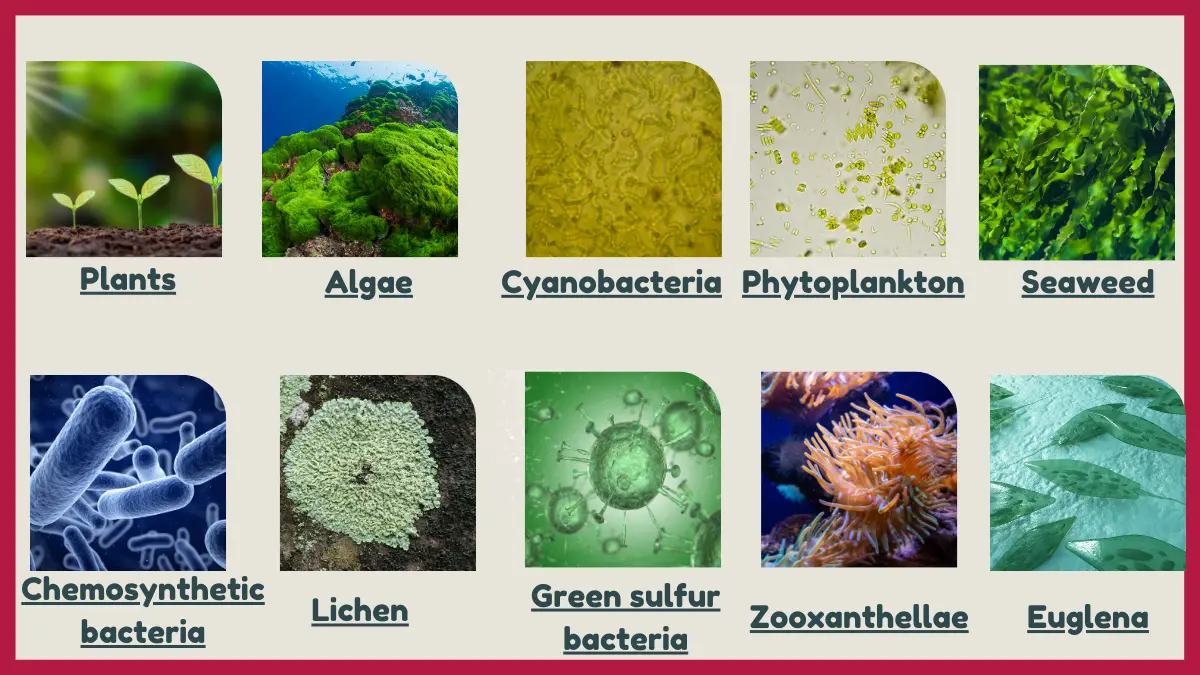Plants, Algae, Cyanobacteria, Phytoplankton, Seaweed, Lichen, and Chemosynthetic bacteria are some most important examples of producers.

Examples of Producers
Here are a few examples of Producers:
1. Plants
Plants are the most common example of producer. They use photosynthesis to convert sunlight, water, and carbon dioxide into oxygen and glucose. Glucose is the primary energy source for plants, and they use it to grow and reproduce. Plants also produce other important molecules, such as proteins, fats, and vitamins, which are essential for life.
2. Algae
Algae are simple aquatic plants that also use photosynthesis to produce food. Algae come in a variety of shapes and sizes, from microscopic single cells to large multicellular seaweeds. Algae play an important role in the aquatic food chain, and they are also used in a variety of commercial products, such as food, cosmetics, and biofuels.
3. Cyanobacteria
Cyanobacteria are photosynthetic bacteria that live in both aquatic and terrestrial environments. Cyanobacteria are sometimes referred to as blue-green algae, but they are not true algae. Cyanobacteria are important producers in both aquatic and terrestrial ecosystems. They also play a role in the nitrogen cycle, which is essential for plant growth.
4. Phytoplankton
Phytoplankton are microscopic algae that float in the ocean. Phytoplankton are the base of the marine food chain, and they are responsible for producing about half of the oxygen in the Earth’s atmosphere. Phytoplankton are also used in a variety of commercial products, such as food supplements and cosmetics.
5. Seaweed
Seaweed is a type of macroalgae that grows in coastal waters. Seaweed is used in a variety of food products, such as sushi, nori, and kelp. Seaweed is also used in a variety of commercial products, such as fertilizers, cosmetics, and biofuels.
6. Chemosynthetic bacteria
Chemosynthetic bacteria obtain energy from chemicals in their environment, such as hydrogen sulfide or methane. Chemosynthetic bacteria do not need sunlight to produce food. Chemosynthetic bacteria play an important role in ecosystems that lack sunlight, such as deep sea vents and hydrothermal vents. Chemosynthetic bacteria are also used in a variety of commercial products, such as biofuels and wastewater treatment.
7. Lichen
Lichen is a symbiotic relationship between a fungus and an alga or cyanobacterium. Lichens can survive in harsh environments, such as rocks and tree bark. Lichens play an important role in breaking down rocks and creating soil. Lichens are also used in a variety of commercial products, such as dyes and food additives.
8. Green sulfur bacteria
Green sulfur bacteria are chemosynthetic bacteria that live in sulfur-rich environments, such as hot springs and hydrothermal vents. Green sulfur bacteria produce oxygen as a byproduct of their photosynthesis. Green sulfur bacteria play an important role in the sulfur cycle, and they are also used in a variety of commercial products, such as biofuels and wastewater treatment.
9. Zooxanthellae
Zooxanthellae are photosynthetic algae that live in the tissues of corals and other marine organisms. Zooxanthellae provide their hosts with food and help them to build reefs. Zooxanthellae are important for the health of coral reefs, and they are also used in a variety of commercial products, such as sunscreen and cosmetics.
10. Euglena
Euglena are unicellular organisms that can produce food through photosynthesis or by ingesting other organisms. Euglena are found in both aquatic and terrestrial environments. Euglena are used in a variety of commercial products, such as food supplements and cosmetics.

